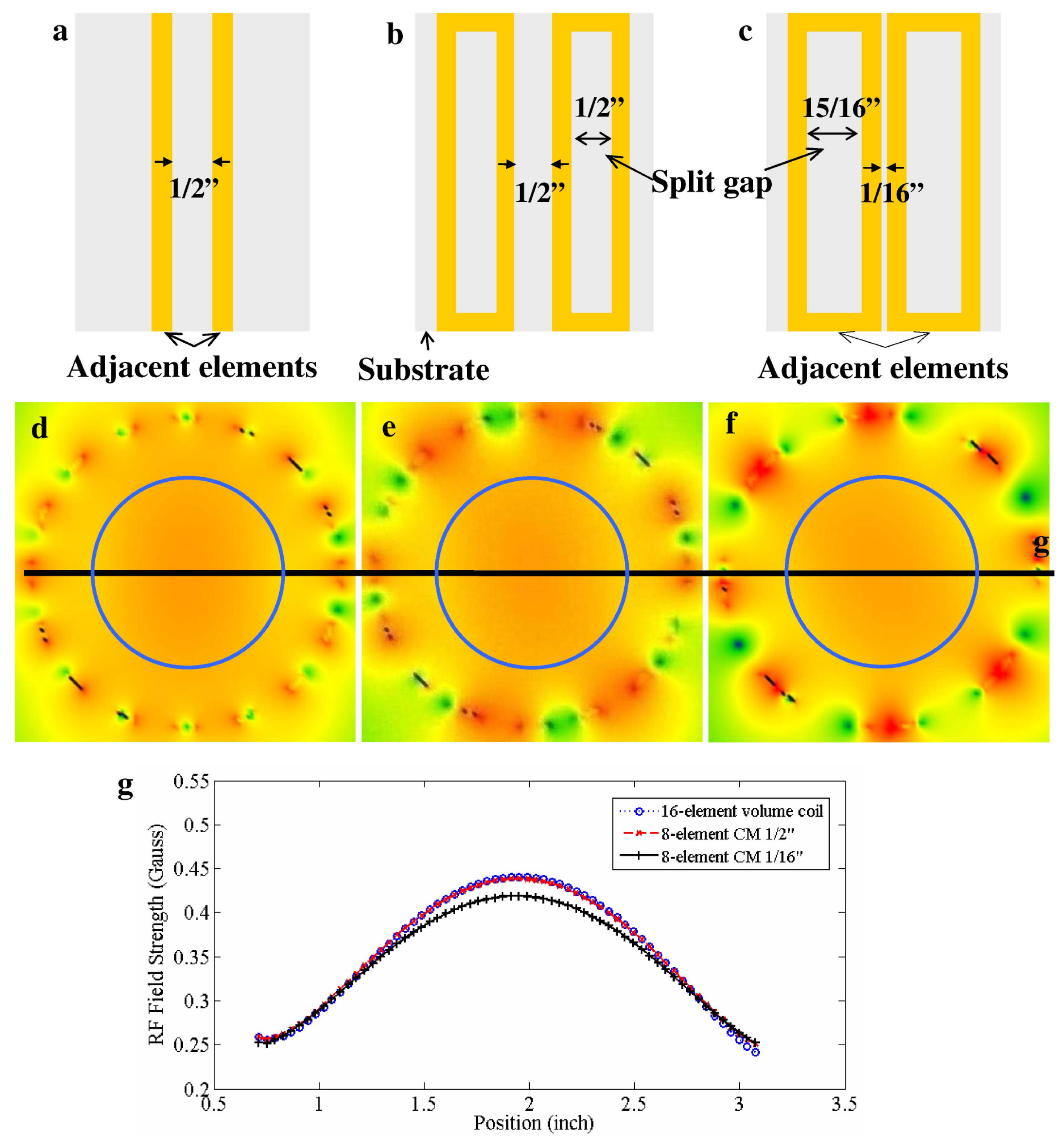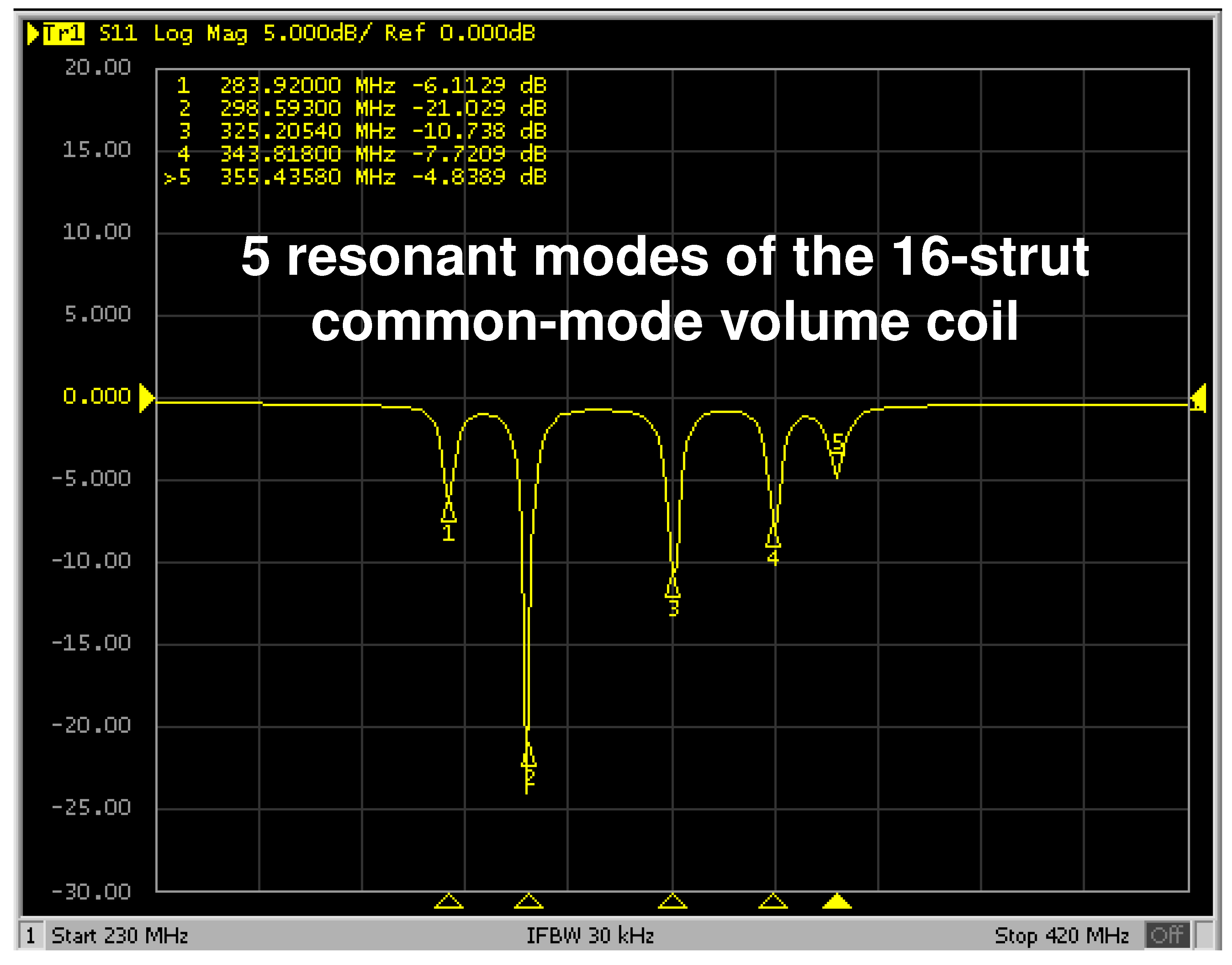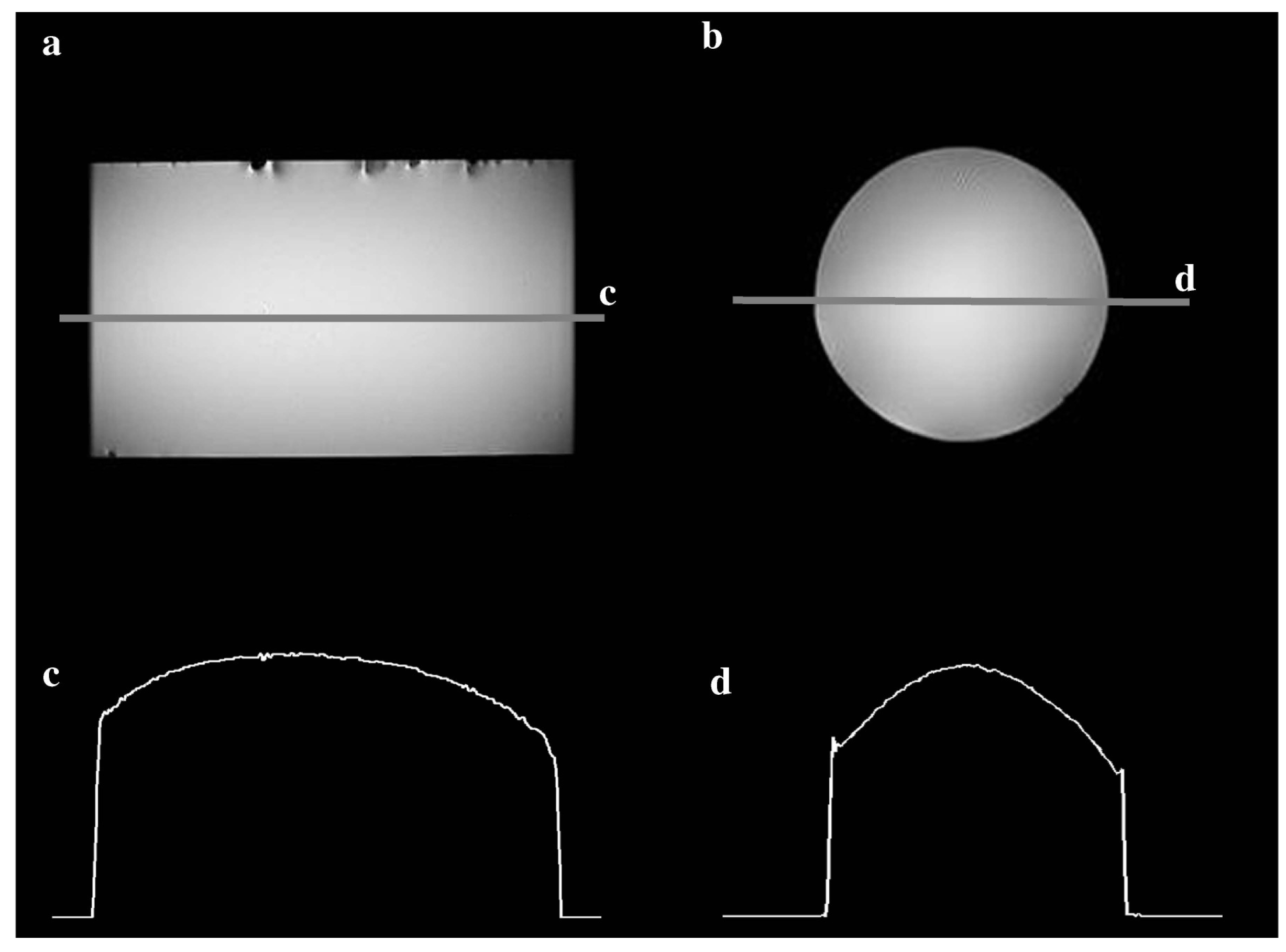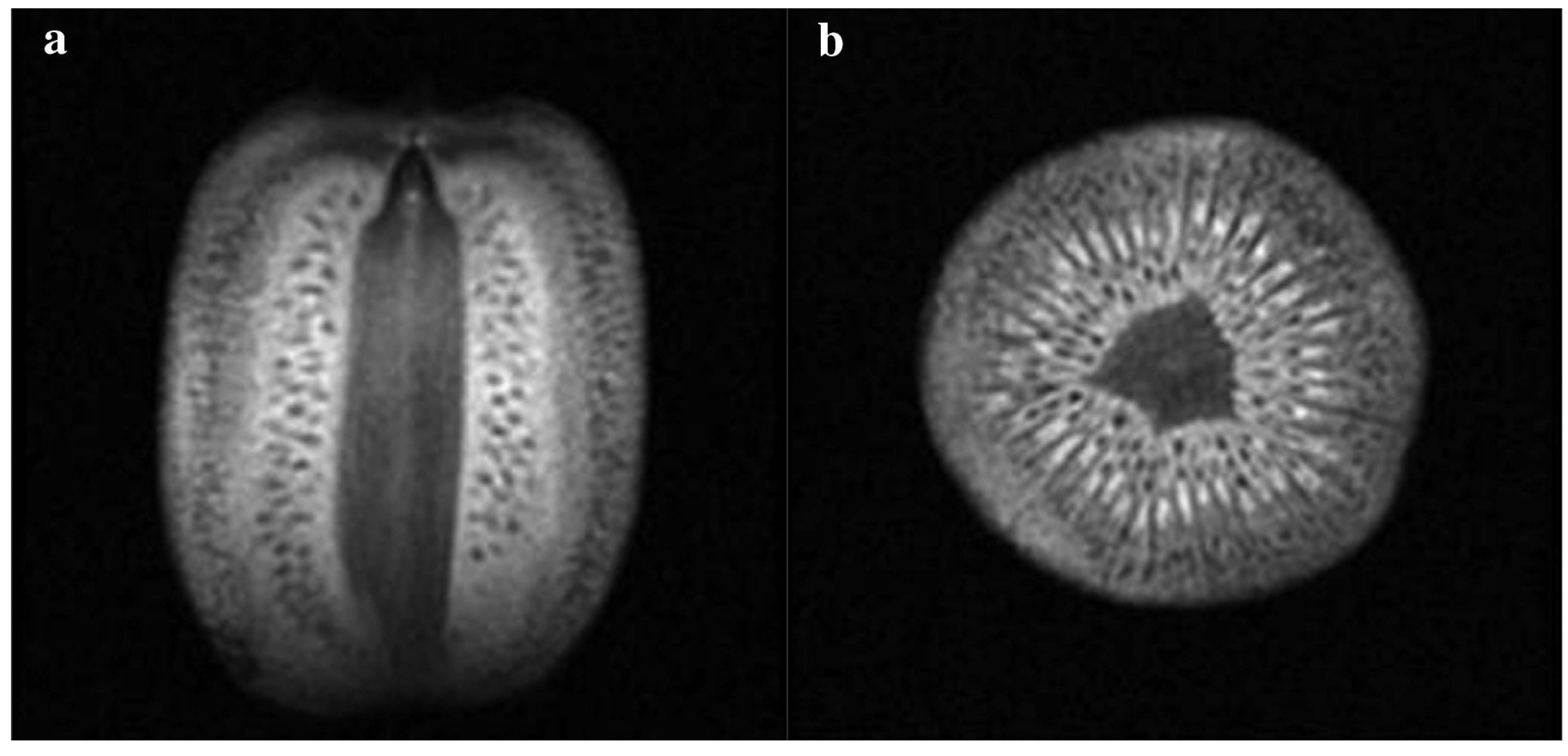Resonant Mode Reduction in Radiofrequency Volume Coils for Ultrahigh Field Magnetic Resonance Imaging
Abstract
:1. Introduction
2. Materials and Methods


3. Results



4. Discussion and Conclusions
Acknowledgement
References
- Hayes, C.E.; Edelstein, W.A.; Schenck, J.F.; Mueller, O.M.; Eash, M. An efficient, highly homogeneous radiofrequency coil for whole-body NMR imaging at 1.5 T. J. Magn. Resonance 1985, 63, 622–628. [Google Scholar]
- Roemer, P.B.; Edelstein, W.A.; Hayes, C.E.; Souza, S.P.; Mueller, O.M. The NMR phased array. Magn. Reson. Med. 1990, 16, 192–225. [Google Scholar] [CrossRef] [PubMed]
- Chang, G.; Friedrich, K.M.; Wang, L.; Vieira, R.L.; Schweitzer, M.E.; Recht, M.P.; Wiggins, G.C.; Regatte, R.R. MRI of the wrist at 7 tesla using an eight-channel array coil combined with parallel imaging: Preliminary results. J. Magn. Reson. Imaging 2010, 31, 740–746. [Google Scholar] [CrossRef] [PubMed]
- Balu, N.; Yarnykh, V.L.; Scholnick, J.; Chu, B.; Yuan, C.; Hayes, C. Improvements in carotid plaque imaging using a new eight-element phased array coil at 3T. J. Magn. Reson. Imaging 2009, 30, 1209–1214. [Google Scholar] [CrossRef] [PubMed]
- Hardy, C.J.; Giaquinto, R.O.; Piel, J.E.; Rohling, K.W.; Marinelli, L.; Blezek, D.J.; Fiveland, E.W.; Darrow, R.D.; Foo, T.K. 128-channel body MRI with a flexible high-density receiver-coil array. J. Magn. Reson. Imaging 2008, 28, 1219–1225. [Google Scholar] [CrossRef] [PubMed]
- Buehrer, M.; Pruessmann, K.P.; Boesiger, P.; Kozerke, S. Array compression for MRI with large coil arrays. Magn. Reson. Med. 2007, 57, 1131–1139. [Google Scholar] [CrossRef] [PubMed]
- Wiggins, G.C.; Triantafyllou, C.; Potthast, A.; Reykowski, A.; Nittka, M.; Wald, L.L. 32-channel 3 Tesla receive-only phased-array head coil with soccer-ball element geometry. Magn. Reson. Med. 2006, 56, 216–223. [Google Scholar] [CrossRef] [PubMed]
- Hardy, C.J.; Cline, H.E.; Giaquinto, R.O.; Niendorf, T.; Grant, A.K.; Sodickson, D.K. 32-element receiver-coil array for cardiac imaging. Magn. Reson. Med. 2006, 55, 1142–1149. [Google Scholar] [CrossRef] [PubMed]
- Zhu, Y.; Hardy, C.J.; Sodickson, D.K.; Giaquinto, R.O.; Dumoulin, C.L.; Kenwood, G.; Niendorf, T.; Lejay, H.; McKenzie, C.A.; Ohliger, M.A.; et al. Highly parallel volumetric imaging with a 32-element RF coil array. Magn. Reson. Med. 2004, 52, 869–877. [Google Scholar] [CrossRef] [PubMed]
- Henry, R.G.; Fischbein, N.J.; Dillon, W.P.; Vigneron, D.B.; Nelson, S.J. High-sensitivity coil array for head and neck imaging: Technical note. AJNR Am. J. Neuroradiol. 2001, 22, 1881–1886. [Google Scholar] [PubMed]
- Weiger, M.; Pruessmann, K.P.; Leussler, C.; Roschmann, P.; Boesiger, P. Specific coil design for SENSE: A six-element cardiac array. Magn. Reson. Med. 2001, 45, 495–504. [Google Scholar] [CrossRef] [PubMed]
- Porter, J.R.; Wright, S.M.; Reykowski, A. A 16-element phased-array head coil. Magn. Reson. Med. 1998, 40, 272–279. [Google Scholar] [CrossRef] [PubMed]
- Hayes, C.E.; Tsuruda, J.S.; Mathis, C.M. Temporal lobes: Surface MR coil phased-array imaging. Radiology 1993, 189, 918–920. [Google Scholar] [CrossRef] [PubMed]
- Zhu, Y. Parallel excitation with an array of transmit coils. Magn. Reson. Med. 2004, 51, 775–784. [Google Scholar] [CrossRef] [PubMed]
- Katscher, U.; Bornert, P.; Leussler, C.; van den Brink, J.S. Transmit SENSE. Magn. Reson. Med. 2003, 49, 144–150. [Google Scholar] [CrossRef] [PubMed]
- Grissom, W.; Yip, C.Y.; Zhang, Z.; Stenger, V.A.; Fessler, J.A.; Noll, D.C. Spatial domain method for the design of RF pulses in multicoil parallel excitation. Magn. Reson. Med. 2006, 56, 620–629. [Google Scholar] [CrossRef] [PubMed]
- Ma, C.; Xu, D.; King, K.F.; Liang, Z.P. Joint design of spoke trajectories and RF pulses for parallel excitation. Magn. Reson. Med. 2011, 65, 973–985. [Google Scholar] [CrossRef] [PubMed]
- Xu, D.; King, K.F.; Zhu, Y.; McKinnon, G.C.; Liang, Z.P. A noniterative method to design large-tip-angle multidimensional spatially-selective radio frequency pulses for parallel transmission. Magn. Reson. Med. 2007, 58, 326–334. [Google Scholar] [CrossRef] [PubMed]
- Sodickson, D.K.; Manning, W.J. Simultaneous acquisition of spatial harmonics (SMASH): Fast imaging with radiofrequency coil arrays. Magn. Reson. Med. 1997, 38, 591–603. [Google Scholar] [CrossRef] [PubMed]
- Pruessmann, K.P.; Weiger, M.; Scheidegger, M.B.; Boesiger, P. SENSE: Sensitivity encoding for fast MRI. Magn. Reson. Med. 1999, 42, 952–962. [Google Scholar] [CrossRef] [PubMed]
- Griswold, M.A.; Jakob, P.M.; Heidemann, R.M.; Nittka, M.; Jellus, V.; Wang, J.; Kiefer, B.; Haase, A. Generalized autocalibrating partially parallel acquisitions (GRAPPA). Magn. Reson. Med. 2002, 47, 1202–1210. [Google Scholar] [CrossRef] [PubMed]
- Xu, D.; King, K.F.; Liang, Z.P. Improving k-t SENSE by adaptive regularization. Magn. Reson. Med. 2007, 57, 918–930. [Google Scholar] [CrossRef] [PubMed]
- Cukur, T.; Santos, J.M.; Pauly, J.M.; Nishimura, D.G. Variable-density parallel imaging with partially localized coil sensitivities. IEEE Trans. Med. Imaging 2010, 29, 1173–1181. [Google Scholar] [CrossRef] [PubMed]
- Lustig, M.; Pauly, J.M. SPIRiT: Iterative self-consistent parallel imaging reconstruction from arbitrary k-space. Magn. Reson. Med. 2010, 64, 457–471. [Google Scholar] [PubMed]
- Ji, J.; Wright, S. Parallel MR imaging with accelerations beyond the number of receiver channels using real image reconstruction. Conf. Proc. IEEE Eng. Med. Biol. Soc. 2005, 1, 735–738. [Google Scholar] [PubMed]
- Li, Y.; Xie, Z.; Pang, Y.; Vigneron, D.; Zhang, X. ICE decoupling technique for RF coil array designs. Med. Phys. 2011, 38, 4086–4093. [Google Scholar] [CrossRef] [PubMed]
- Vaughan, J.T.; Adriany, G.; Snyder, C.J.; Tian, J.; Thiel, T.; Bolinger, L.; Liu, H.; DelaBarre, L.; Ugurbil, K. Efficient high-frequency body coil for high-field MRI. Magn. Reson. Med. 2004, 52, 851–859. [Google Scholar] [CrossRef] [PubMed]
- Zhang, X.; Ugurbil, K.; Chen, W. A microstrip transmission line volume coil for human head MR imaging at 4T. J. Magn. Reson. 2003, 161, 242–251. [Google Scholar] [CrossRef] [PubMed]
- Wiggins, G.C.; Potthast, A.; Triantafyllou, C.; Wiggins, C.J.; Wald, L.L. Eight-channel phased array coil and detunable TEM volume coil for 7 T brain imaging. Magn. Reson. Med. 2005, 54, 235–240. [Google Scholar] [CrossRef] [PubMed]
- Avdievich, N.I.; Hetherington, H.P. 4 T Actively detuneable double-tuned 1H/31P head volume coil and four-channel 31P phased array for human brain spectroscopy. J. Magn. Reson. 2007, 186, 341–346. [Google Scholar] [CrossRef] [PubMed]
- Vaughan, J.T.; Adriany, G.; Garwood, M.; Yacoub, E.; Duong, T.; DelaBarre, L.; Andersen, P.; Ugurbil, K. Detunable transverse electromagnetic (TEM) volume coil for high-field NMR. Magn. Reson. Med. 2002, 47, 990–1000. [Google Scholar] [CrossRef] [PubMed]
- Wen, H.; Chesnick, A.S.; Balaban, R.S. The design and test of a new volume coil for high field imaging. Magn. Reson. Med. 1994, 32, 492–498. [Google Scholar] [CrossRef] [PubMed]
- Kneeland, J.B.; Jesmanowicz, A.; Froncisz, W.; Hyde, J.S. Simultaneous reception from a whole-volume coil and a surface coil on a clinical MR system. Radiology 1988, 169, 255–257. [Google Scholar] [CrossRef] [PubMed]
- Alecci, M.; Collins, C.M.; Smith, M.B.; Jezzard, P. Radio frequency magnetic field mapping of a 3 Tesla birdcage coil: Experimental and theoretical dependence on sample properties. Magn. Reson. Med. 2001, 46, 379–385. [Google Scholar] [CrossRef] [PubMed]
- Collins, C.M.; Smith, M.B. Signal-to-noise ratio and absorbed power as functions of main magnetic field strength, and definition of “90 degrees” RF pulse for the head in the birdcage coil. Magn. Reson. Med. 2001, 45, 684–691. [Google Scholar] [CrossRef] [PubMed]
- Fujita, H.; Braum, W.O.; Morich, M.A. Novel quadrature birdcage coil for a vertical B(0) field open MRI system. Magn. Reson. Med. 2000, 44, 633–640. [Google Scholar] [CrossRef] [PubMed]
- Ibrahim, T.S.; Lee, R.; Baertlein, B.A.; Robitaille, P.M. B1 field homogeneity and SAR calculations for the birdcage coil. Phys. Med. Biol. 2001, 46, 609–619. [Google Scholar] [CrossRef] [PubMed]
- Jin, J.; Shen, G.; Perkins, T. On the field inhomogeneity of a birdcage coil. Magn. Reson. Med. 1994, 32, 418–422. [Google Scholar] [CrossRef] [PubMed]
- Shen, G.X.; Boada, F.E.; Thulborn, K.R. Dual-frequency, dual-quadrature, birdcage RF coil design with identical B1 pattern for sodium and proton imaging of the human brain at 1.5 T. Magn. Reson. Med. 1997, 38, 717–725. [Google Scholar] [CrossRef] [PubMed]
- Murphy-Boesch, J.; Srinivasan, R.; Carvajal, L.; Brown, T.R. Two configurations of the four-ring birdcage coil for 1H imaging and 1H-decoupled 31P spectroscopy of the human head. J. Magn. Reson. B 1994, 103, 103–114. [Google Scholar] [CrossRef] [PubMed]
- Lin, F.H.; Kwong, K.K.; Huang, I.J.; Belliveau, J.W.; Wald, L.L. Degenerate mode birdcage volume coil for sensitivity-encoded imaging. Magn. Reson. Med. 2003, 50, 1107–1111. [Google Scholar] [CrossRef] [PubMed]
- Wang, C.; Qu, P.; Shen, G.X. Potential advantage of higher-order modes of birdcage coil for parallel imaging. J. Magn. Reson. 2006, 182, 160–167. [Google Scholar] [CrossRef] [PubMed]
- Joseph, P.M.; Lu, D. A technique for double resonant operation of birdcage imaging coils. IEEE Trans. Med. Imaging 1989, 8, 286–294. [Google Scholar] [CrossRef] [PubMed]
- Tropp, J. The theory of the birdcage resonator. J. Magn. Reson. Imaging 1989, 82, 51–62. [Google Scholar]
- Vullo, T.; Zipagan, R.T.; Pascone, R.; Whalen, J.P.; Cahill, P.T. Experimental design and fabrication of birdcage resonators for magnetic resonance imaging. Magn. Reson. Med. 1992, 24, 243–252. [Google Scholar] [CrossRef] [PubMed]
- Vaughan, J.T.; Hetherington, H.P.; Otu, J.O.; Pan, J.W.; Pohost, G.M. High frequency volume coils for clinical NMR imaging and spectroscopy. Magn. Reson. Med. 1994, 32, 206–218. [Google Scholar] [CrossRef] [PubMed]
- Zhang, X.; Ugurbil, K.; Sainati, R.; Chen, W. An inverted-microstrip resonator for human head proton MR imaging at 7 tesla. IEEE Trans. Biomed. Eng. 2005, 52, 495–504. [Google Scholar] [CrossRef] [PubMed]
- Duan, Y.; Peterson, B.S.; Liu, F.; Brown, T.R.; Ibrahim, T.S.; Kangarlu, A. Computational and experimental optimization of a double-tuned (1)H/(31)P four-ring birdcage head coil for MRS at 3T. J. Magn. Reson. Imaging 2009, 29, 13–22. [Google Scholar] [CrossRef] [PubMed]
- Xie, Z.; Xu, D.; Vigneron, D.B.; Zhang, X. Common mode volume coil design for in vivo MR imaging at 7T. In Proceedings of the 17th Annual Meeting of ISMRM, Honolulu, HI, USA, 18–24 April 2009; p. 2957.
- Sekino, M.; Kim, D.; Ohsaki, H. Finite-difference time-domain simulations of radio frequency electromagnetic fields and signal inhomogeneities in ultrahigh-field magnetic resonance imaging systems. J. Appl. Phys. 2008, 103, 07A318:1–07A318:3. [Google Scholar] [CrossRef]
- Collins, C.M.; Smith, M.B. Calculations of B(1) distribution, SNR, and SAR for a surface coil adjacent to an anatomically-accurate human body model. Magn. Reson. Med. 2001, 45, 692–699. [Google Scholar] [CrossRef] [PubMed]
- Yang, Q.X.; Wang, J.; Zhang, X.; Collins, C.M.; Smith, M.B.; Liu, H.; Zhu, X.H.; Vaughan, J.T.; Ugurbil, K.; Chen, W. Analysis of wave behavior in lossy dielectric samples at high field. Magn. Reson. Med. 2002, 47, 982–989. [Google Scholar] [CrossRef] [PubMed]
- Lee, R.F.; Westgate, C.R.; Weiss, R.G.; Newman, D.C.; Bottomley, P.A. Planar strip array (PSA) for MRI. Magn. Reson. Med. 2001, 45, 673–683. [Google Scholar] [CrossRef] [PubMed]
- Zhang, X.; Ugurbil, K.; Chen, W. Microstrip RF surface coil design for extremely high-field MRI and spectroscopy. Magn. Reson. Med. 2001, 46, 443–450. [Google Scholar] [CrossRef] [PubMed]
- Wu, B.; Wang, C.; Kelley, D.A.; Xu, D.; Vigneron, D.B.; Nelson, S.J.; Zhang, X. Shielded microstrip array for 7T human MR imaging. IEEE Trans. Med. Imaging 2010, 29, 179–184. [Google Scholar] [CrossRef] [PubMed]
- Wu, B.; Wang, C.; Krug, R.; Kelley, D.A.; Xu, D.; Pang, Y.; Banerjee, S.; Vigneron, D.B.; Nelson, S.J.; Majumdar, S.; Zhang, X. 7T human spine imaging arrays with adjustable inductive decoupling. IEEE Trans. Biomed. Eng. 2010, 57, 397–403. [Google Scholar] [CrossRef] [PubMed]
- Zhang, X.; Zhu, X.H.; Chen, W. Higher-order harmonic transmission-line RF coil design for MR applications. Magn. Reson. Med. 2005, 53, 1234–1239. [Google Scholar] [CrossRef]
© 2011 by the authors; licensee MDPI, Basel, Switzerland. This article is an open access article distributed under the terms and conditions of the Creative Commons Attribution license (http://creativecommons.org/licenses/by/3.0/).
Share and Cite
Pang, Y.; Xie, Z.; Li, Y.; Xu, D.; Vigneron, D.; Zhang, X. Resonant Mode Reduction in Radiofrequency Volume Coils for Ultrahigh Field Magnetic Resonance Imaging. Materials 2011, 4, 1333-1344. https://doi.org/10.3390/ma4081333
Pang Y, Xie Z, Li Y, Xu D, Vigneron D, Zhang X. Resonant Mode Reduction in Radiofrequency Volume Coils for Ultrahigh Field Magnetic Resonance Imaging. Materials. 2011; 4(8):1333-1344. https://doi.org/10.3390/ma4081333
Chicago/Turabian StylePang, Yong, Zhentian Xie, Ye Li, Duan Xu, Daniel Vigneron, and Xiaoliang Zhang. 2011. "Resonant Mode Reduction in Radiofrequency Volume Coils for Ultrahigh Field Magnetic Resonance Imaging" Materials 4, no. 8: 1333-1344. https://doi.org/10.3390/ma4081333



